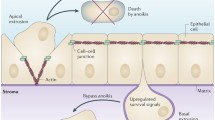Abstract
The induction of a tumour in the basal layer of an epithelium has been simulated by computer. The primary assumption is that tumour growth begins when a single abnormal cell divides faster than surrounding normal cells by a factor K, the “carcinogenic advantage”.
Similar content being viewed by others
References
Bullough, W. S., and Laurence, E. B., Proc. Roy. Soc., B, 151, 307 (1960).
Leblond, C., Messier, B., and Kopriwa, B., Lab. Invest., 8, 296 (1959).
Bjerknes, R., and Iversen, O. H., Proc. First Intern. Symp. Biokybernetik (edit. by Drischel, H.), 253 (Karl Marx Universität, 1968).
Hausdorff, F., Math. Ann., 79, 157 (1918).
Mandelbrot, B., Science, 156, 636 (1967).
Eden, M., in Proc. Fourth Berkeley Symp. on Mathematical Statistics and Probability, 4, 223 (University of California Press, 1961).
Williams, T., J. Roy. Stat. Soc., B, 27, 338 (1965).
Author information
Authors and Affiliations
Rights and permissions
About this article
Cite this article
WILLIAMS, T., BJERKNES, R. Stochastic Model for Abnormal Clone Spread through Epithelial Basal Layer. Nature 236, 19–21 (1972). https://doi.org/10.1038/236019a0
Received:
Issue Date:
DOI: https://doi.org/10.1038/236019a0
- Springer Nature Limited
This article is cited by
-
Dynamics of Advantageous Mutant Spread in Spatial Death-Birth and Birth-Death Moran Models
Communications on Applied Mathematics and Computation (2023)
-
Improved Upper Bounds on the Asymptotic Growth Velocity of Eden Clusters
Journal of Statistical Physics (2020)
-
Spatial Measures of Genetic Heterogeneity During Carcinogenesis
Bulletin of Mathematical Biology (2017)
-
Optimal treatment and stochastic modeling of heterogeneous tumors
Biology Direct (2016)
-
Spatial Moran models, II: cancer initiation in spatially structured tissue
Journal of Mathematical Biology (2016)





